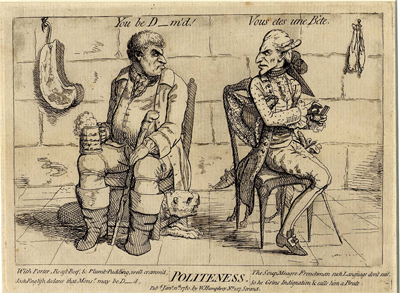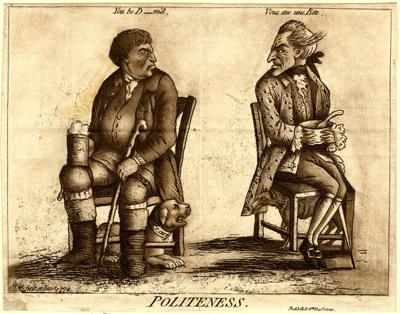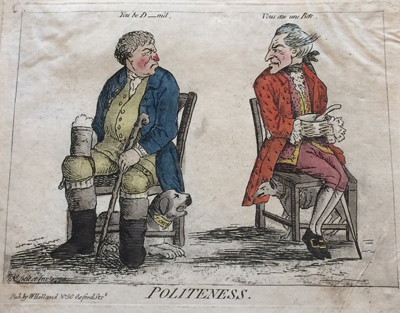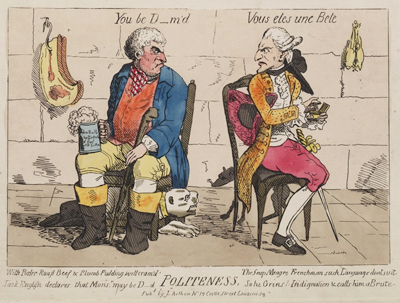Politeness
The ironically titled Politeness may be best appreciated as an exercise in national caricature. A vivid contrast between an Englishman and a Frenchman, the print seems to be an almost perfect embodiment of the intersection between caricature and national stereotype.

Politeness
[January 11, 1780]
© Trustees of the British Museum
One of the functions of both caricature and stereotyping is to simplify, to deliberately ignore the complexity of reality and to substitute a convenient reduction of that reality—often for political or emotional purposes. The French and English had been enemies and/or competitors for hundreds of years, and when Politeness was first published in late 1779 and early 1780 (more of that later), England was once again at war with France for siding with the revolutionaries in the American war for independence. So there was plenty of reason for creating an image of a Frenchman that almost any Britton would love to hate and to provide a contrasting and more normative) image of John Bull (or Jack English), the sterotypical Englishman. And as we will see, the print could be (and was) reissued a number of times since England and France were almost continually at war.
Some of the characteristics that define the two figures in Politeness can, in fact, be found in other earlier prints, for instance, in Hogarth's The Gate of Calais, Beer Street, and The Invasion and in John Collet's Frenchman in London and Grown Gentlemen Taught to Dance. But in Politness, those characteristics are unusually concentrated.
The Englishmen is stout and well fed; the Frenchman is lean and stick-like. The Englishman sports his own hair; the Frenchman, a powdered bag wig. The Englishman carries a wooden club; the Frenchman, a thin rapier. The Englishman is dressed simply for out of doors with jack boots and a plain jacket, vest, and cravat; the Frenchman is dressed as if for a soirée with slippers, fancy coat, and a shirt with ruffles at his wrists and neck. The Englishman grips an overflowing tankard of porter; the Frenchman reaches with two fingers for a pinch of snuff. The Englishman sits squarely in his chair with his legs somewhat apart; the Frenchman sits near the edge of the chair his legs pressed primly together. Even their chairs differ: the Englishman's chair has a solid seat and legs while the Frenchmen's chair is as elegant and spindly as the Frenchman himself. Their dogs follow suit. The English bull mastiff is fierce and powerful-looking with a square-ish face that resembles his master; the French greyhound is thin and sleak with a sharply pointed nose that visually echoes the nose and chin of the Frenchman. Behind them are examples of the very different national diets that result in such contrasts— the English roast beef (of course) versus the French frogs.
The caption underlines the difference and hostility of the two nations.
With Porter Roast Beef & Plumb Pudding well cram'd,
Jack English declares that Monsr may be D------d.
The Soup Meagre Frenchman such Language dont suit,
So he Grins Indignation & calls him a Brute
Publication History
There are as many as five slightly different versions of this print and at least two states of one of them, from several publishers.* Not all of the versions are dated, however, making the publication history of the print something of a puzzle. But, thankfully, in several cases, the publication location can at least establish the earliest possible date for the appearance of a version. That said, here is my chronological construction of the publication history based on the available evidence. To make it easier to distinguish the versions, I've given them names.
- The Nixon version (1789). Created and etched by John Nixon. No publisher listed. Published December 8, 1779.
- The William Humphrey version (1780). A significant redrawing and revision of #1, probably by Gillray who had begun working with William Humphrey as early as 1775. Published by William Humphrey. Publication date January 11, 1780, roughly a month after the Nixon version.
- The Holland version (After 1786). Based on #1. Published by William Holland. No publication date, but no earlier than 1786 when Holland moved from Drury Lane to the Oxford Street address listed on Politeness.
- The Aitken version (After 1788). Based on #2, but with simpler detail and shading. Possibly by Gillray. Published by James Aitken. No publication date, but sometime after Aitken moved to Castle Street which Mathew Crowther (the Printshop Window) estimates was between August 1788 and May 1789.
- The Hannah Humphrey version (After 1797). A copy of #4 with the Aitken publication line overwritten. Published by Hannah Humphrey. No publication date, but no earlier than 1797, when Hannah Humphrey moved her shop to St. James's Street.
Versions
Nixon Version.. The first and original version was by John Nixon, a merchant and amateur artist best known for his caricatures and watercolor landscapes. His landscapes were typically etched by other hands, but his caricatures and social satires were drawn and etched by himself. In this case, Nixon claims responsibility for both the drawing and finishing of the plate, using a combination of etching and stipple engraving. Unlike the William Humphrey version above, there is no caption, and no background wall. The Frenchman holds a bowl of soup instead of a snuff box, the greyhound stands under (not behind) the Frenchman's chair, and the greyhound's expression is closer to the snarl of the Frenchman. The soup in the Nixon version is presumably the "soup meagre" mentioned in the caption (but not in the illustration) of the Humphrey version, which may suggest that the caption was originally created for the Nixon version but (for whatever reason) not used.

Politeness
[December 8, 1779]
© Trustees of the British Museum
The Nixon version includes the earliest known publication date (December 8, 1779), but is lacking any information about a publisher. Nixon seems to have worked with a variety of publishers over the course of his career, including William Humphrey, William Wells, J. Harris, W. Holland, and Edward Harding. The earliest prints attributed to Nixon (Magisterial Oeconomy (1779) and Magisterial Bruisers were published by Humphrey; the earliest definitely signed prints like An Essay on Hats (1781), by Wells.
William Humphrey Version.. The next version (published January 11, 1780) was what I am calling the William Humphrey version which the British Museum describes as "Unquestionably by Gillray." This contains all the most obvious additions and corrections to the Nixon version mentioned above. Those include the background wall with its hanging roast beef and frogs, a larger point size for the insults exchanged between the two figures, the cowering (not snarling) greyhound, the snuff-box in place of the soup bowl, a hat under the Frenchman's arm, a more delicate and elegant chair, and a label on the tankard of porter saying "John Bull the Buttock of Beef. . .".

Politeness
[January 11, 1780]
© Trustees of the British Museum
Holland Version.. At least six years later, the Nixon version (#1) formed the basis of another extremely rare version of the print by W. Holland. Identical in every respect except for the stippling, the Holland version looks like it may have been a traced and colored version of Nixon's original print. It has no publication date, but the publisher address is listed as 50 Oxford Street, which Holland moved into no earlier than 1786. Nixon created other caricatures with Holland in 1789, and, of course, the storming of the bastille in July 1789 put France and everything French in the spotlight again, so the Holland version may date from 1789.

© Private Collection
Aitken Version.. Sometime after 1788, when James Aitken moved his shop to 14 Castle Street, the address listed on the Politeness print, yet another version of Politeness appeared–this one based, not on the Nixon version (#1), but the Humphrey version (#2). The etching in this one, however, is simpler, cleaner with fewer instances of cross hatching, perhaps because it was planned with color in mind. The caption, also has been redone not only to replace Humphrey with Aitken, but also to increase the point-size and spacing. (Note how The word "D____d" is much closer to the title in the Aitken version. Gillray started working with Aitken in 1788, publishing approximately 10 prints with Aitken in 1789, so it is certainly possible that this version is also by Gillray, copying (for the most part) from his own William Humphrey version.**

Politeness
[After 1788]
© Teylers Museum
Hannah Humphrey Version..
Some time after 1797 when she moved to her St. James's Street location, Hannah Humphrey published her own version of Politeness. It was a minimal effort, simply striking out the publication line of Aitken's version and adding her own.

© Trustees of the British Museum
Why and how did she come to use the Aitken version when one would think she could have used the William Humphrey version upon which it was based? One possibility is that the William Humphrey plate was lost. After all it was now at least seventeen years (and three relocations) since the William Humphrey version was published. But is is also possible if Gillray was the etcher of the Aitken version, he may have used the Humphrey plate, burnishing away what he didn't need and adding what he wanted. So the Humphrey plate, in effect, no longer existed. In either case by 1797 Aitken would have been just out of prison, virtually bankrupt and quite willing to sell off any rights he had to the Politeness plate/print. And Hannah Humphrey might have had less qualms about taking over the plate since the various non-Nixon iterations could all be traced to Gillray.
* Thanks to Tim Clayton, Donald Coverdale, and Omek Marks for making me aware of the multiple versions and states of the print.
** Donald Coverdale, in an email to me, questions my suggestion that Gillray may be responsible for the Aitken and H. Humphrey versions, noting that "The word 'Politeness', while similar to Gillray's writing, is unlikely (in my opinion) to be in Gillray's hand because it is not as well done as Gillray's own writing. The letters are rather uneven; there is a comma rather than a full stop after 'Politeness' (Gillray invariably used full stops but not commas in titles); the other words in the caption are engraved with less confidence than Gillray's engraving and do not appear to be his writing. If Gillray engraved the plate it is unlikely that he would have delegeted the engraving of the title to someone else because he had, after all, been trained as a letter-engraver in his youth and this was his speciality."
Sources and Reading
- Commentary from the British Museum on Politeness.
- "John Colley Nixon," Wikipedia
- "A Biographical Sketch of James Aitken," The Printshop Window
Comments & Corrections
NOTE: Comments and/or corrections are always appreciated. To make that easier, I have included a form below that you can use. I promise never to share any of the info provided without your express permission.